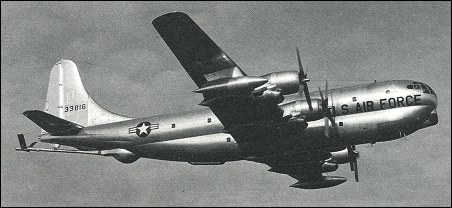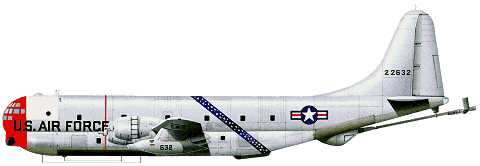 |
Boeing 367 / C-971944 |  |
| TRANSPORT | Virtual Aircraft Museum / USA / Boeing |
 |
In early 1942 Boeing initiated a design study to examine the feasibility of producing a transport version of its B-29 Superfortress. In due course the company's proposal was submitted to the USAAF for consideration and, because at that time the long-range transport was a much-needed type of aircraft, a contract for three prototypes was awarded on 23 January 1943. Identified by the company as the Boeing Model 367, and designated XC-97 by the US Army Air Force, the first made its maiden flight on 15 November 1944. The XC-97 had much in common with the B-29, including the entire wing and engine layout. At first view the fuselage, of 'double-bubble' section, appeared to be entirely new, but in fact the lower 'bubble' was basically a B-29 structure, and so was the tail unit attached to the new (and larger) upper 'bubble'. On 6 July 1945, following brief evaluation of the prototypes, 10 service-test aircraft were ordered. These comprised six YC-97 cargo transports, three YC-97A troop carriers, and a single YC-97B with 80 airline-type seats in its main cabin. The first production contract, on 24 March 1947, for 27 C-97A aircraft with 2425kW Pratt & Whitney R-4360-27 engines, specified accommodation for 134 troops, or the ability to carry a 24,040kg payload. Two transport versions followed, under the designation C-97C and VC-97D, and following trials with three KC-97A aircraft equipped with additional tankage and a Boeing-developed flight-refuelling boom, KC-97E flight-refuelling tankers went into production in 1951. This version was powered by 2610kW R-4360-35C engines. The KC-97F variant which followed differed only in having R-4360-59B engines. Both the KC-97E and KC-97F were convertible tanker/transports, but for full transport capability the flight-refuelling equipment had to be removed. The most numerous variant, with 592 built, was the KC-97G which had full tanker or full transport capability without any on-unit equipment change. When production ended in 1956 a total of 888 C-97s had been built, and many were converted later for other duties. The KC-97L variant had increased power by the installation of a 2359kg thrust General Electric J47-GE-23 turbojet beneath each wing to improve rendezvous compatibility with Boeing B-47s. KC-97Gs converted to all-cargo configuration were redesignated C-97G, and in all-passenger configuration became C-97K. Search and rescue conversions were HC-97G, and three KC-97Ls went to the Spanish air force, being designated TK-1 in that service. Several have served in many roles with Israel's air force. Variants C-97D: designation applied to the third YC-97A, the YC-97B, and two C-97As following conversion to a standard passenger configuration; the three VC-97Ds were subsequently redesignated C-97D KC-97H: designation applied to one KC-97F, following modification for service trials as a tanker using the probe-and-drogue flight-refuelling system developed in the UK YC-97J: final designation of two KC-97Gs converted for USAF use as flying test-beds, each with four 4250kW (5,700-shp) Pratt & Whitney YT43-P-5 turboprop engines Boeing 367 / C-97 on YOUTUBE

|  COMPANY PROFILE | |||||||||||||||||||||||||||||||||||||||||||||||||||||
 |

|
